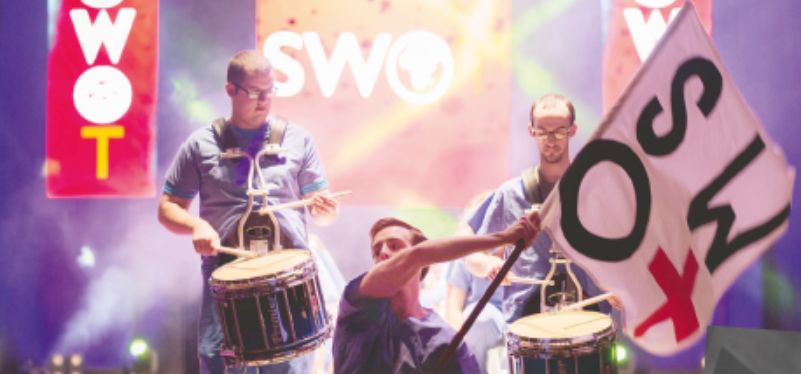SWOT
SWOT (Students Working Overseas Trust ) was set up to raise money for essential medical supplies. Almost 40 years later, their annual fashion show is one of the biggest events on campus.

Today, SWOT is a Queen’s institution. The lights, the catwalk, the outfits, the dance routines… and those legendary moments such as when the men’s Gaelic football and rugby team members take their tops off. But less known are the hidden bits: the hours of practice, the endless petitioning of local businesses for sponsorship, the sleepless nights. And what about the name?
SWOT is the brainchild of one person and named as an in-joke between her and a friend. “In 1984, I was a third-year medic spending my Friday nights working at A&E in the Royal Victoria Hospital in Belfast, but I had ambitions to go to Africa and help people there,” says Dr Anne Carson (Medicine, 1987). “However, my immediate reality was somewhat different. I spent downtime studying and learning how to stitch, and my friend used to call me a swot.”
One day, while taking part in a squash match at Trinity College Dublin, she spotted a group of medics running blood pressure clinics to raise money for charity. That evening, advised by a friend who worked for the World University Service, she applied to set up a charity that could raise money to buy medical supplies. In honour of the friend, she called it the Students Working Overseas Trust – SWOT.
The newly formed trust was soon so successful at running blood pressure clinics in shopping centres around Belfast that they started to cause unforeseen problems. “People called us the ‘Wee Doctors’,” Carson says. “We wore white coats and had a homemade banner. Back then, people never went to the doctor, and the men who were waiting fortheir wives to shop would give us a pound or two to test their blood pressure, and we referred them to the GP if necessary. But we ended up referring so many that we skewed the results of an important study running at the time – the World Health Organization’s MONICA hypertension study. So the University asked us to stop."

By then, SWOT had already raised more than £35,000 to buy equipment, which Carson planned to take out to a hospital in Uganda where she had arranged a placement. “I had a donated ultrasound machine, a suction machine and re-sterilised needles from the Royal. Incredibly, the security team at the airport let me put it all on the plane – for free! It was definitely a very different time.”
Carson worked in a city hospital in Kampala run by Franciscan nuns. “I drained abscesses and treated slim disease and leprosy – the experience was wonderful!” She also got swept up in a coup against the then Ugandan president. “I was performing a C-section while troops shot at each other across the compound. It was foolish, but I was 21 and I didn’t have £500 to change my flight back. We only had a wind-up telephone in the compound, so thankfully my parents had no idea. Was I scared? I come from Tyrone, from the ‘murder triangle’, and it wasn’t anything worse than I was used to.” And it meant SWOT was up and running.
Back home, as well as eventually being allowed to take up blood pressure clinics again, the committee found other, creative ways of raising funds, including a fashion show that would go on to become the Queen’s event of the year. “The catwalk thing really got people’s attention,” says clinical professor Gerry Gormley, a medical student and a committee member in 1995, when the fashion show was in its infancy. “It was fun, exciting, something everyone really looked forward to. There was such a vibrancy about it, and it really brought our year group together.”
In 2003, Gormley returned to Queen’s to teach medicine, and has since mentored members of the SWOT committee, supporting however he can – including participating in the staff dance. “We used to be left to ourselves to choreograph it,” he says, “and really it was like dads dancing at a wedding. Bringing in a student choreographer was a step change, and in 2018 we did a pretty slick routine to Justin Timberlake’s Can’t Stop the Feeling. Dancing doesn’t come easily to me, but I don’t mind making an eejit of myself for a good cause.” Year on year, the show has become more spectacular, he says. “In 2018, they brought in the world dances, from Irish dancing to the African and Caribbean Society. That made it about more than fashion; it was about celebrating diversity and making change, and it really made your heart sing.”
But despite the glitz, glamour and photographers from Ulster Tatler, there’s a moment halfway through the event, says Gormley, when everyone remembers what they’re there for. “They pause the dancing and show a montage of what they’ve done with the money raised. I think it was 2017 they played Coldplay’s Fix You, and it was really emotional. You remember how privileged you are, and it’s a window on all the need in the world. It really stops you in your tracks.”

In 2018, SWOT raised more than £70,000 for health projects all over the world. The then president, Niamh Murphy (Medicine, 2019), took £8,000 to a hospital in Bali, where she worked in paediatric oncology for four weeks. “We worked with the medical director there to make a plan,” she says. “They needed beds, so that’s what we bought. The treatment the patients got depended on how much money they had, and there were hundreds of people in the waiting room, some sleeping on the floor.” The students pay for their own travel, so every penny goes to the hospitals they work in.
Murphy, now a paediatric trainee, was inspired by what SWOT did, but hadn’t realised how much work it would be until she was elected on to the committee. “You’re continuously calling the businesses,” she says, “trying to set up meetings to raise funds or to borrow clothes. You’re constantly practising the dance routines, so you’re always a wee bit tired – you lean on each other. You have to be really organised throughout the year so you don’t fall behind in your work. One of my main memories from the year is spending every Sunday in the Students’ Union practising the dances, having numerous cups of tea, then having dinner all together.” The stress, she says, comes from just how much everyone wants the night to succeed. With a crowd of 1,200, each having paid £40 or so for a ticket, the stakes are high.
Alongside the boys’ dance, another highlight for Murphy was the girls’ wedding dance, complete with grooms and other bridal features. “A group of us went to a bridal shopin Belfast to choose our wedding dresses. It was brilliant. We had become so tightknit over the year – you’re with people you didn’t know before you joined the committee, but you spend so much time together. We’re still friends now.”
For anyone on the committee, especially the president, the best dance is the last one. “The committee comes out last,” Murphy says, “so we’re all waiting behind the curtain. When you come out on stage it’s such a fantastic feeling, the crowd cheering all the work you’ve done and finishing up together, as a team.”
Carson, now a radiologist and chair of the British Medical Association’s Northern Ireland Consultants Committee, doesn’t make it to the fashion show every year, but she’s nonetheless extremely proud of what SWOT has become. “I love to see how it’s developed,” she says.
“As well as doing good, it gives students confidence, makes them work as a team, and creates such a sense of belonging and achievement. It makes them more well-rounded people and, therefore, better doctors.”
GET INVOLVED If you’d like to support next year’s event, email editor@qub.ac.uk